Prediction Model for Transient NOx Emission of Diesel Engine Based on CNN-LSTM Network
Abstract
1. Introduction
2. Experimental Section and Method
2.1. Experimental Equipment
2.2. Experimental Scheme
3. Data Preprocessing
3.1. Data Correlation Analysis
3.2. Data Normalization Processing
4. Construction of Emission Prediction Model Based on CNN-LSTM
4.1. CNN Neural Network
4.2. LSTM Neural Network
4.3. CNN-LSTM Neural Network Prediction Model
4.3.1. Determination of Structural Parameters of CNN-LSTM Neural Network
4.3.2. Optimization of Super-Parameter of Prediction Model by Grid Search Method
- 1.
- Determine the search range for the hyperparameters in the LSTM network prediction module of this model. Pass this range to the grid search function, which will organize all possible combinations within the specified range. Define the search range for the hyperparameters as follows: model depth ; The number of neurons in the hidden layer ; Batch size ;
- 2.
- Different CNN-LSTM neural network prediction models are constructed based on each parameter combination;
- 3.
- The loss function is defined to evaluate the performance of model parameters, and the mean square error (MSE) is adopted as the chosen loss function. The calculation formula for updating the MSE is shown in Equation (14):where is the total sample number, is the true value, and is the predicted value.
- 4.
- Set the number of network epochs iterations to 50, and obtain the final value of the loss function for each prediction model after the network training reaches the maximum learning iteration;
- 5.
- The optimal solution with the minimum loss function value is selected to determine the optimal hyperparameter combination for the CNN-LSTM network prediction model.
5. Training, Verification, and Comparison of Forecasting Model
5.1. Training and Verification of Prediction Model
5.2. Model Prediction Evaluation Index
5.3. Comparison of Model Prediction
- The structure of the CNN prediction model optimized by grid search consists of three convolutional layers, one maximum pooling layer, and two fully connected layers. The number of convolutional kernels is set to 16, 32, and 64, with a kernel size and pooled kernel size of 1 × 3. The pooled characteristic data is then fitted through the fully connected layers. To prevent overfitting, the ReLU activation function is employed. This configuration enables the prediction of transient NOx emissions in diesel engines;
- The LSTM network prediction model optimized by grid search is a network structure composed of one input layer, two hidden layers (each containing 64 neurons), one output layer, and one fully connected layer. The MSE is utilized as the loss function in order to predict the transient NOx emissions of diesel engines;
- The structure of the BP neural network prediction model optimized by the grid search consists of one input layer, eleven hidden layers, and one output layer. Each hidden layer is comprised of 35 neurons. This network configuration, which utilizes the mean square error as the loss function, enables the prediction of transient NOx emissions in diesel engines.
6. Conclusions
- The CNN-LSTM network prediction model combines the powerful memory capability of the LSTM network in time series prediction with the CNN’s ability to extract deep features from the transient NOx emission data of diesel engines. This integration enables the model to uncover the intricate relationship between the characteristics of transient NOx emission data and enhance the accuracy of predicting diesel engine transient NOx emissions;
- The CNN-LSTM network prediction model exhibits faster convergence speed and lower training loss compared to the LSTM network and BP neural network prediction models. However, it falls slightly short when compared to the CNN prediction model. Nonetheless, this prediction model demonstrates greater robustness when compared to the LSTM network and BP neural network prediction models;
- Compared to the LSTM network prediction model, the CNN-LSTM network prediction model exhibits significant improvements in accuracy metrics. Specifically, it demonstrates a reduction in MAE and RMSE by 18.9% and 35.6%, respectively, while R2 increases by 2.5%. When compared to the CNN neural network prediction model, the MAE and RMSE decrease by 43.7% and 50.8% respectively, and R2 increases by 4.4%. In comparison to the BP neural network prediction model, the MAE and RMSE decrease by 43.1% and 62.9%, respectively, while R2 increases by 6.6%. These results unequivocally highlight the superior accuracy of the CNN-LSTM network prediction model in forecasting transient NOx emissions from diesel engines;
- Compared to CNN, LSTM network, and BP neural network prediction models, the CNN-LSTM network prediction model exhibits a notable absence of significant deviation points in the prediction of the NOx emission for each concentration under transient thermal cycle conditions of diesel engines. It demonstrates low dispersion, high prediction precision, and improved fitting effect.
Author Contributions
Funding
Data Availability Statement
Conflicts of Interest
Nomenclature
| CNN | Convolutional neural network |
| LSTM | Long short-term neural network |
| CNN-LSTM | Convolutional neural network-long short-term memory networks |
| BP | Back propagation |
| NOx | Nitrogen oxides |
| WHTC | World harmonized transient cycle |
| R2 | R-Square |
| RMSE | Root mean square error |
| MAE | Mean absolute error |
| MSE | Mean square error |
| MAPE | Mean absolute percentage error |
| DOC | Diesel oxidation catalytic |
| DPF | Diesel particulate filter |
| SCR | Selective catalytic reduction |
| 1D-CNN | One-dimensional convolutional neural network |
| 2D-CNN | Two-dimensional convolutional neural network |
| 3D-CNN | Three-dimensional convolutional neural network |
| RNN | Recurrent neural network |
| ReLU | Rectified Linear Units |
| tanh | Hyperbolic tangent |
| Total sample number | |
| Rank difference of two variables after sorting | |
| Corresponding input parameter | |
| Emission value of NOx | |
| Spearman correlation coefficient | |
| Pearson correlation coefficient | |
| Covariance | |
| Standard deviation | |
| Activation function | |
| Input feature size | |
| Correspond bias | |
| Convolution operation | |
| Feature map | |
| Value obtained after convolution operation | |
| Value of the pooling layer output matrix | |
| Value of the pooling layer input matrix | |
| Boundary value of the region participating in the set | |
| Output value of the fully connected layer | |
| Input value of the fully connected layer | |
| Weigh matrix | |
| Bias vector | |
| Value of forget gate | |
| Sigmoid function | |
| Implied unit | |
| Value of input gate | |
| Offset term of the input gate | |
| Cell case | |
| Value of output gate | |
| True value | |
| Predicted value | |
| Average of the actual responses |
References
- Tan, Y.H.; Abdullah, M.O.; Nolasco-Hipolito, C.; Zauzi, N.S.A.; Abdullah, G.W. Engine performance and emissions characteristics of a diesel engine fueled with diesel-biodiesel-bioethanol emulsions. Energy Convers. Manag. 2017, 132, 54–64. [Google Scholar] [CrossRef]
- Lou, D.M.; Wang, Y.X.; Sun, Y.Z.; Zhang, Y.H. Effect of DOC carrier length on emission performance of diesel engine. J. Tongji Univ. Nat. Sci. 2019, 47, 548–553, 592. [Google Scholar]
- Hu, J.; Lin, F.; Wang, T.T.; Liu, B.; Li, Y.H.; Zhang, Z.Y. Prediction of diesel engine NOx emission based on neural network partial least squares. Trans. CSICE 2015, 33, 510–515. [Google Scholar]
- Rao, V.; Honnery, D. A comparison of two NOx prediction schemes for use in diesel engine thermodynamic modelling. Fuel 2013, 107, 662–670. [Google Scholar] [CrossRef]
- Park, W.; Lee, J.; Min, K.; Yu, J.; Park, S.; Cho, S. Prediction of real-time NO based on the in-cylinder pressure in Diesel engines. Proc. Combust. Inst. 2013, 34, 3075–3082. [Google Scholar] [CrossRef]
- Özgül, E.; Bedir, H. Fast NOx emission prediction methodology via one-dimensional engine performance tools in heavy-duty engines. Adv. Mech. Eng. 2019, 11, 168781401984595. [Google Scholar] [CrossRef]
- Lee, Y.; Lee, S.; Min, K. Real-time NOx estimation in light duty diesel engine with in-cylinder pressure prediction. Int. J. Engine Res. 2021, 22, 146808742110157. [Google Scholar] [CrossRef]
- Zhang, L.; Wen, J.; Li, Y.; Chen, J.; Ye, Y.; Fu, Y.; Livingood, W. A review of machine learning in building load prediction. Appl. Energy 2021, 285, 116452. [Google Scholar] [CrossRef]
- Altan, A.; Karasu, S.; Zio, E. A new hybrid model for wind speed forecasting combining long short-term memory neural network, decomposition methods and grey wolf optimizer. Appl. Soft Comput. 2020, 100, 106996. [Google Scholar] [CrossRef]
- Yu, Y.; Wang, Y.; Li, J.; Fu, M.; Shah, A.N.; He, C. A Novel Deep Learning Approach to Predict the Instantaneous NOx Emissions from Diesel Engine. IEEE Access 2021, 9, 11002–11013. [Google Scholar] [CrossRef]
- Dai, J.C.; Pang, H.L.; Yu, Y.; Bu, J.G.; Zi, X.Y. Prediction of Diesel Engine NOx Emission Based on Long-Short Term Memory Neural Network. Trans. CSICE 2020, 38, 457–463. [Google Scholar]
- Shin, S.; Lee, Y.; Kim, M.; Park, J.; Lee, S.; Min, K. Deep neural network model with Bayesian hyperparameter optimization for prediction of NOx at transient conditions in a diesel engine. Eng. Appl. Artif. Intell. 2020, 94, 103761. [Google Scholar] [CrossRef]
- Yang, R.; Yang, L.; Tan, S.L.; Zhang, S.; Huang, W.; Huang, J.M. Prediction Model for Transient NOx Emission of Diesel Engine Based on GA-Long Short Term Memory (LSTM) Neural Network. Chin. Intern. Combust. Engine Eng. 2022, 43, 10–17. [Google Scholar]
- Zhang, Z.; Cui, P.; Zhu, W. Deep Learning on Graphs: A Survey. IEEE Trans. Knowl. Data Eng. 2020, 34, 249–270. [Google Scholar] [CrossRef]
- Gao, J.; Wang, H.; Shen, H. Task Failure Prediction in Cloud Data Centers Using Deep Learning. IEEE Trans. Serv. Comput. 2020, 15, 1411–1422. [Google Scholar] [CrossRef]
- Arsov, M.; Zdravevski, E.; Lameski, P.; Corizzo, R.; Koteli, N.; Gramatikov, S.; Mitreski, k.; Trajkovik, V. Multi-Horizon Air Pollution Forecasting with Deep Neural Networks. Sensors 2021, 21, 1235. [Google Scholar] [CrossRef]
- Bak, G.; Bae, Y. Predicting the Amount of Electric Power Transaction Using Deep Learning Methods. Energies 2020, 13, 6649. [Google Scholar] [CrossRef]
- Lee, S.; Lee, Y.; Lee, Y.; Kim, M.; Shin, S.; Park, J.; Min, K. EGR Prediction of Diesel Engines in Steady-State Conditions Using Deep Learning Method. Int. J. Automot. Technol. 2020, 21, 571–578. [Google Scholar] [CrossRef]
- Tian, Y. Artificial Intelligence Image Recognition Method Based on Convolutional Neural Network Algorithm. IEEE Access 2020, 8, 125731–125744. [Google Scholar] [CrossRef]
- Ma, Z.; Huang, G.D. Image Recognition and Analysis: A Complex Network-Based Approach. IEEE Access 2022, 10, 109537–109543. [Google Scholar] [CrossRef]
- Elmaz, F.; Eyckerman, R.; Casteels, W.; Latré, S.; Hellinckx, P. CNN-LSTM architecture for predictive indoor temperature modeling. Build. Environ. 2021, 206, 108327. [Google Scholar] [CrossRef]
- Bai, S.; Han, J.; Liu, M.; Qin, S.; Wang, G.; Li, G. Experimental investigation of exhaust thermal management on NOx emissions of heavy-duty diesel engine under the world Harmonized transient cycle (WHTC). Appl. Therm. Eng. 2018, 142, 421–432. [Google Scholar] [CrossRef]
- De Winter, J.C.F.; Gosling, S.D.; Potter, J. Comparing the Pearson and Spearman correlation coefficients across distributions and sample sizes: A tutorial using simulations and empirical data. Psychol. Methods 2016, 21, 273–290. [Google Scholar] [CrossRef]
- Feng, W.; Zhu, Q.; Zhuang, J.; Yu, S. An expert recommendation algorithm based on Pearson correlation coefficient and FP-growth. Clust. Comput. 2018, 22, 7401–7412. [Google Scholar] [CrossRef]
- Xiao, C.; Ye, J.; Esteves, R.M.; Rong, C. Using Spearman’s correlation coefficients for exploratory data analysis on big dataset. Concurr. Comput. Pract. Exp. 2015, 28, 3866–3878. [Google Scholar] [CrossRef]
- Zhang, W.Y.; Wei, Z.W.; Wang, B.H.; Han, X.P. Measuring mixing patterns in complex networks by Spearman rank correlation coefficient. Phys. A Stat. Mech. Its Appl. 2016, 451, 440–450. [Google Scholar] [CrossRef]
- Bishara, A.J.; Hittner, J.B. Testing the significance of a correlation with nonnormal data: Comparison of Pearson, Spearman, transformation, and resampling approaches. Psychol. Methods 2012, 17, 399–417. [Google Scholar] [CrossRef]
- Kattenborn, T.; Leitloff, J.; Schiefer, F.; Hinz, S. Review on Convolutional Neural Networks (CNN) in vegetation remote sensing. ISPRS J. Photogramm. Remote Sens. 2021, 173, 24–49. [Google Scholar] [CrossRef]
- Sindi, H.; Nour, M.; Rawa, M.; Öztürk, Ş.; Polat, K. Random fully connected layered 1D CNN for solving the Z-bus loss allocation problem. Measurement 2021, 171, 108794. [Google Scholar] [CrossRef]
- Liu, Y.; Cheng, Q.; Shi, Y.W.; Wang, Y.W.; Wang, S.; Deng, A. Fault Diagnosis of Rolling Bearings Based on Attention Module And 1d-Cnn. Acta Energ. Sol. Sin. 2022, 43, 462–468. [Google Scholar]
- Basiri, M.E.; Nemati, S.; Abdar, M.; Cambria, E.; Acharrya, U.R. ABCDM: An Attention-based Bidirectional CNN-RNN Deep Model for sentiment analysis. Future Gener. Comput. Syst. 2020, 115, 279–294. [Google Scholar] [CrossRef]
- Zhao, J.; Deng, F.; Cai, Y.; Chen, J. Long short-term memory—Fully connected (LSTM-FC) neural network for PM2.5 concentration prediction. Chemosphere 2019, 220, 486–492. [Google Scholar] [CrossRef]
- Onan, A.; Tocoglu, M.A. A Term Weighted Neural Language Model and Stacked Bidirectional LSTM Based Framework for Sarcasm Identification. IEEE Access 2021, 9, 7701–7722. [Google Scholar] [CrossRef]
- Barbero Jiménez, Á.; López Lázaro, J.; Dorronsoro, J.R. Finding optimal model parameters by deterministic and annealed focused grid search. Neurocomputing 2009, 72, 2824–2832. [Google Scholar] [CrossRef]
- Yang, W.; Pu, C.X.; Yang, K.; Zhang, A.A.; Qu, G.L. Short-term fault prediction method for a transformer based on a CNN-GRU combined neural network. Power Syst. Prot. Control 2022, 50, 107–116. [Google Scholar]
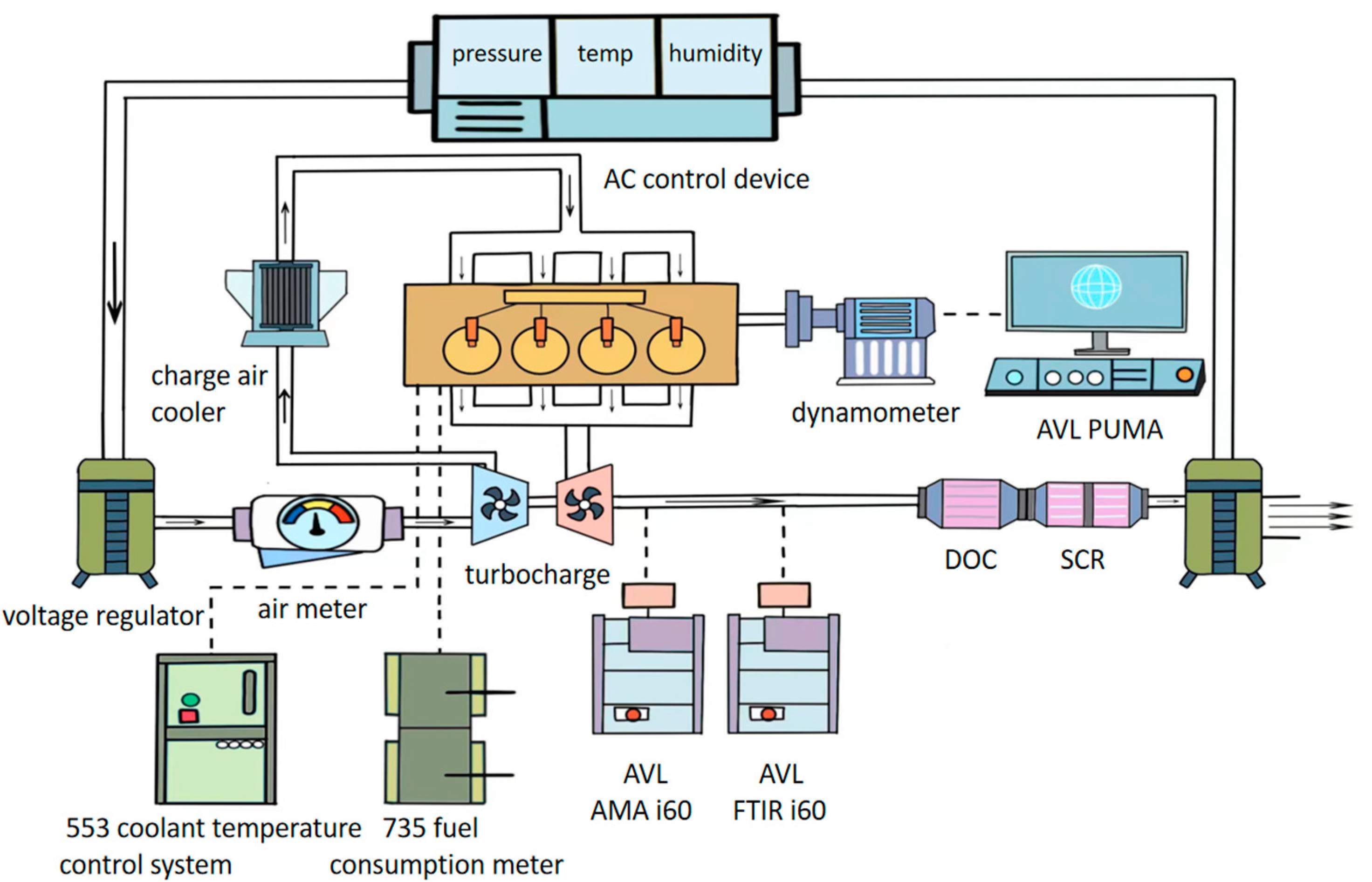
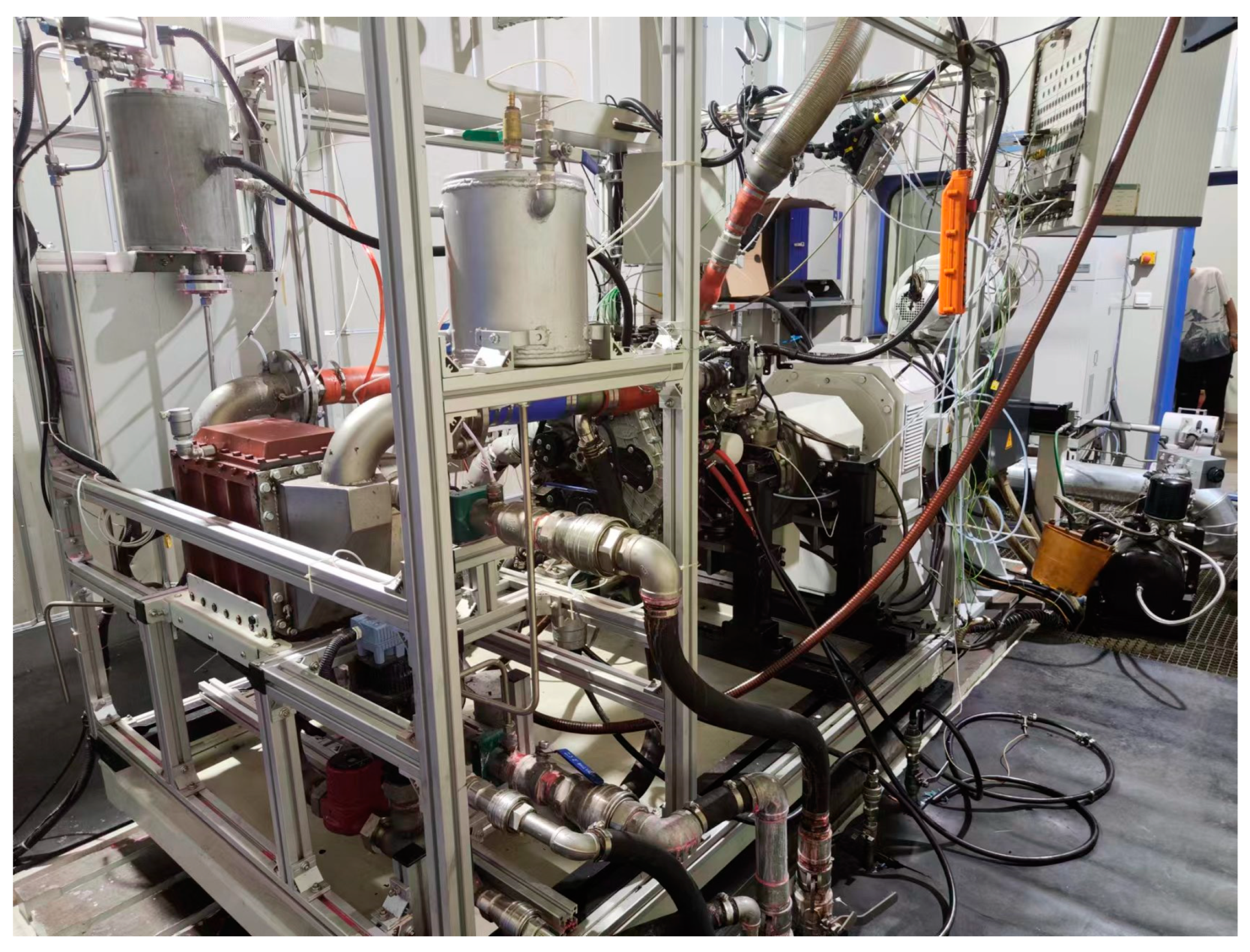
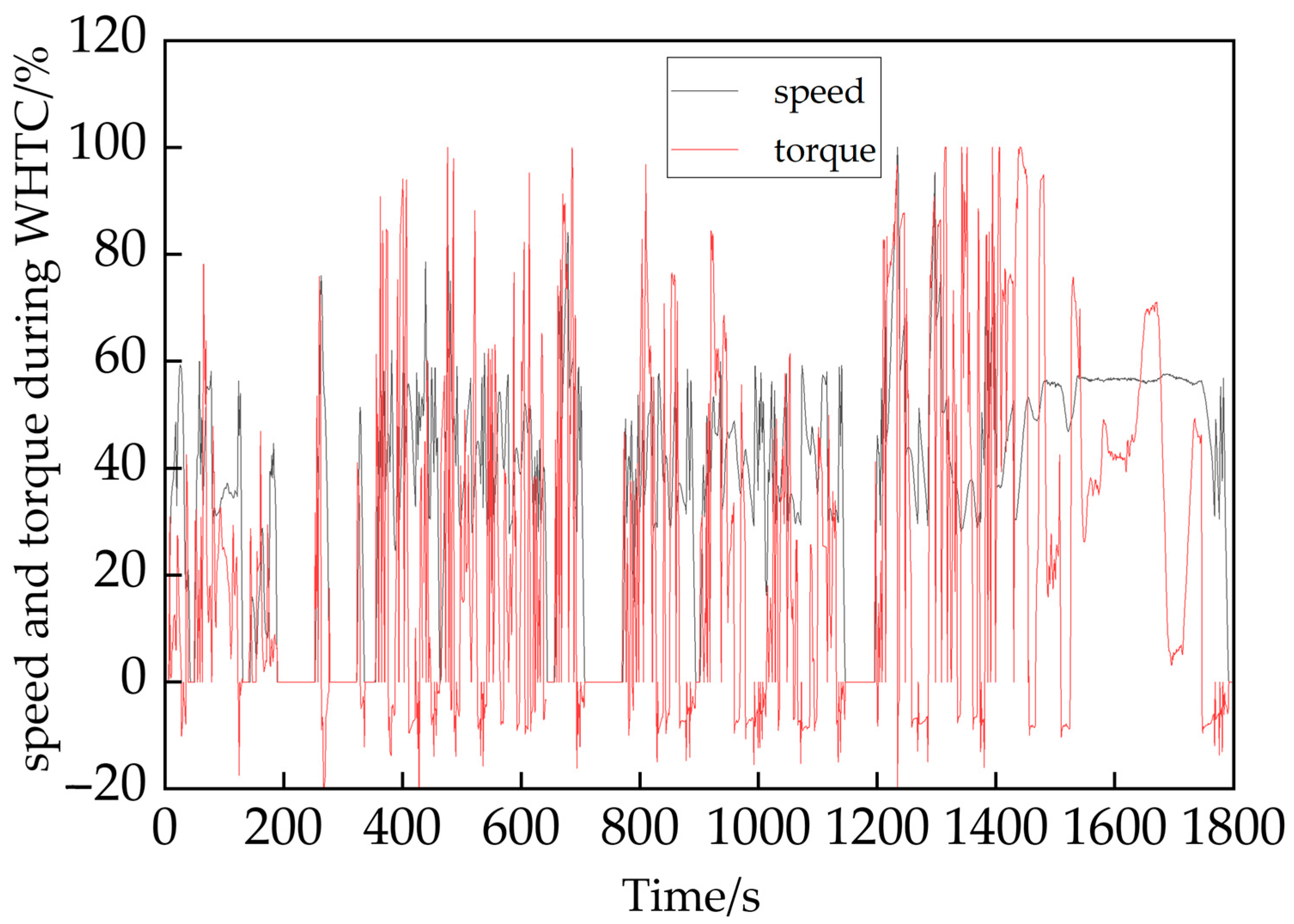

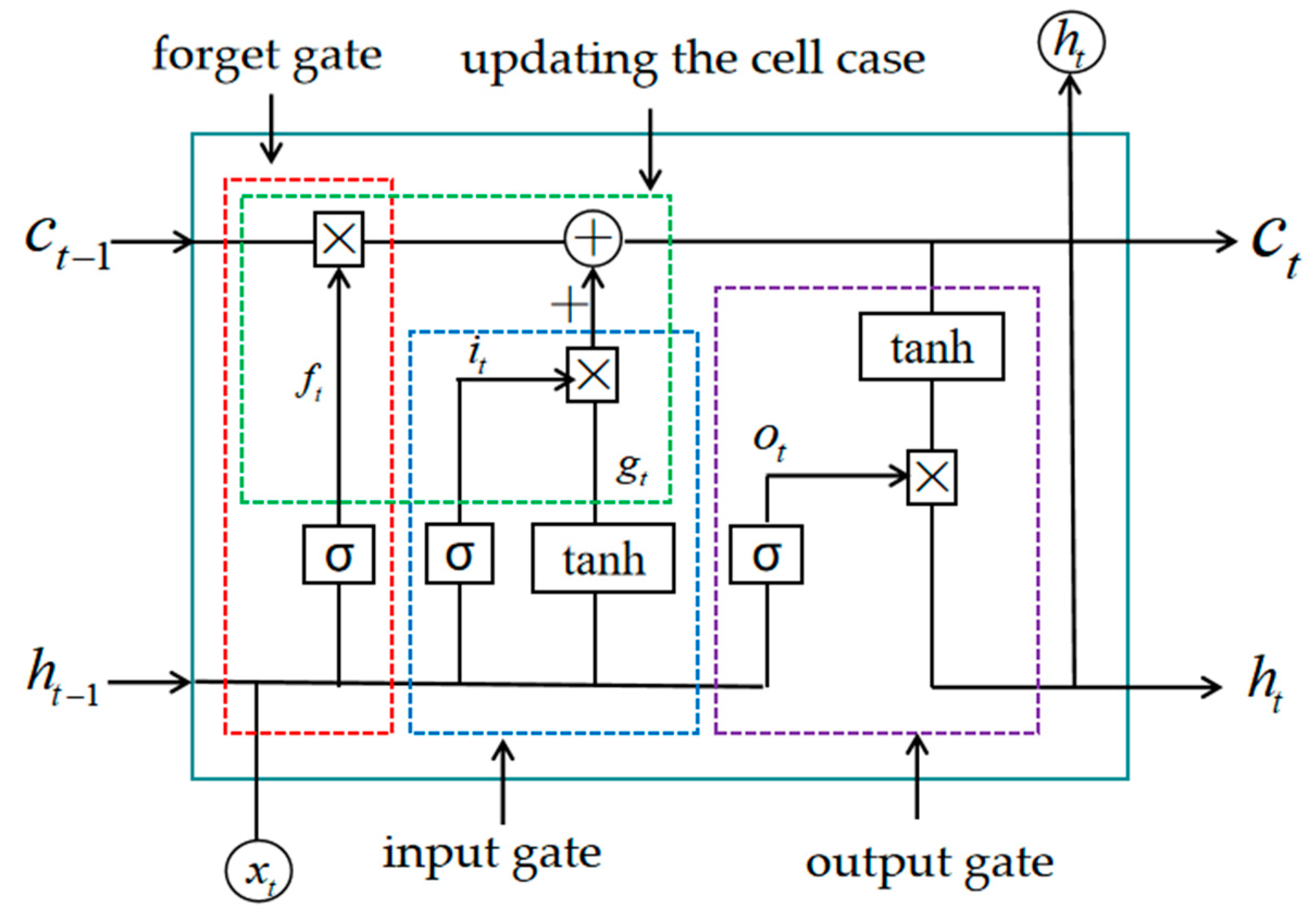

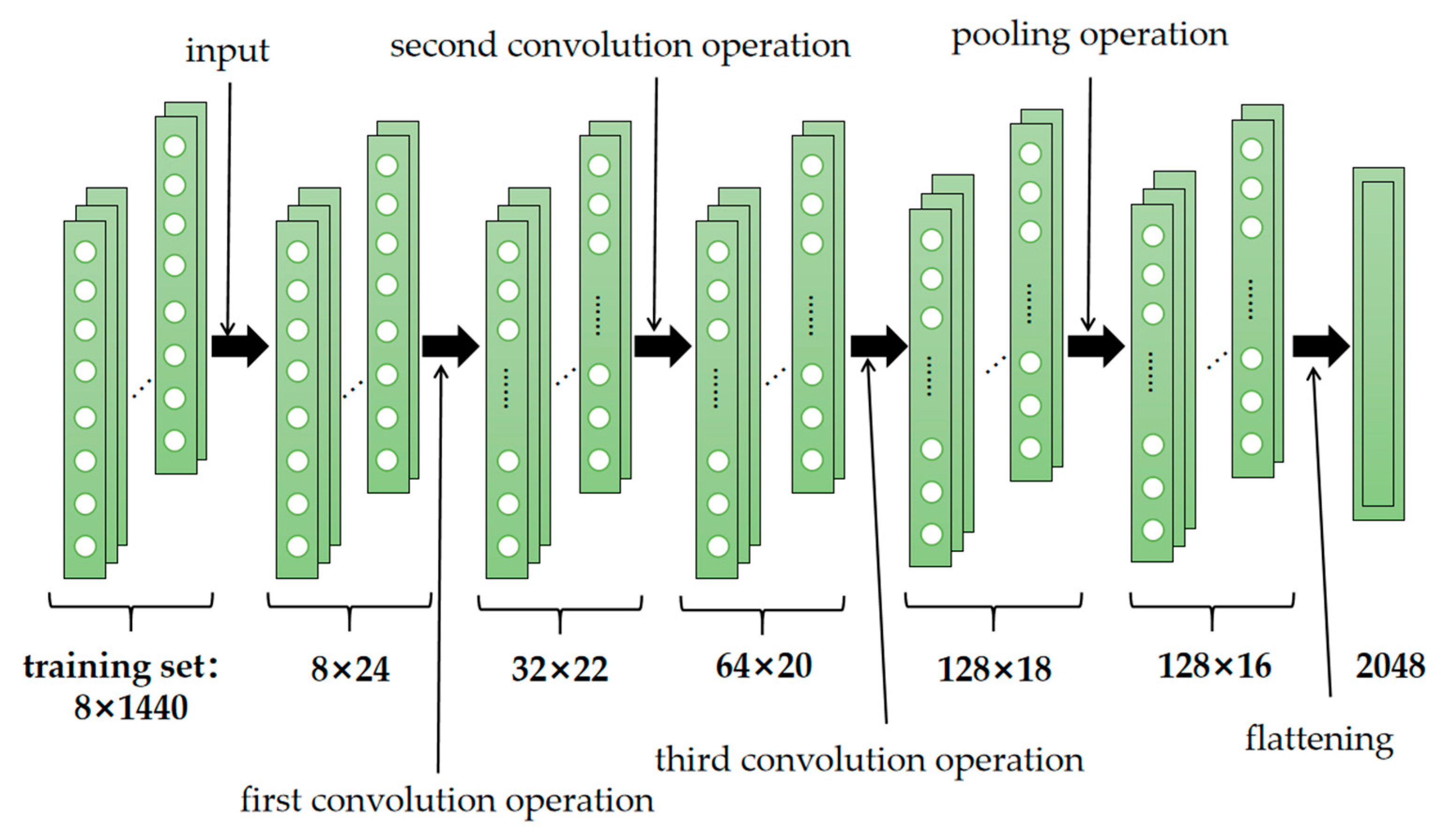

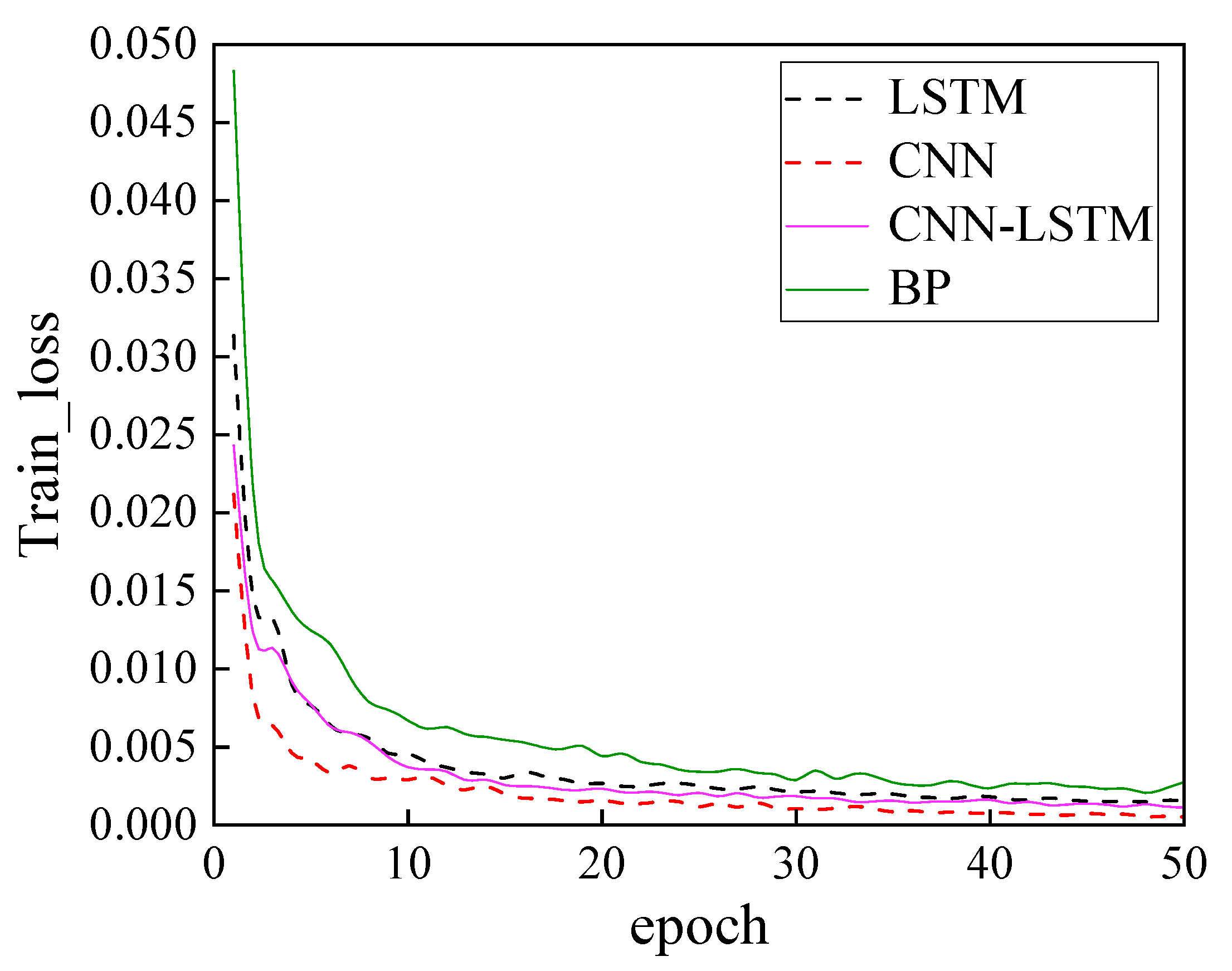

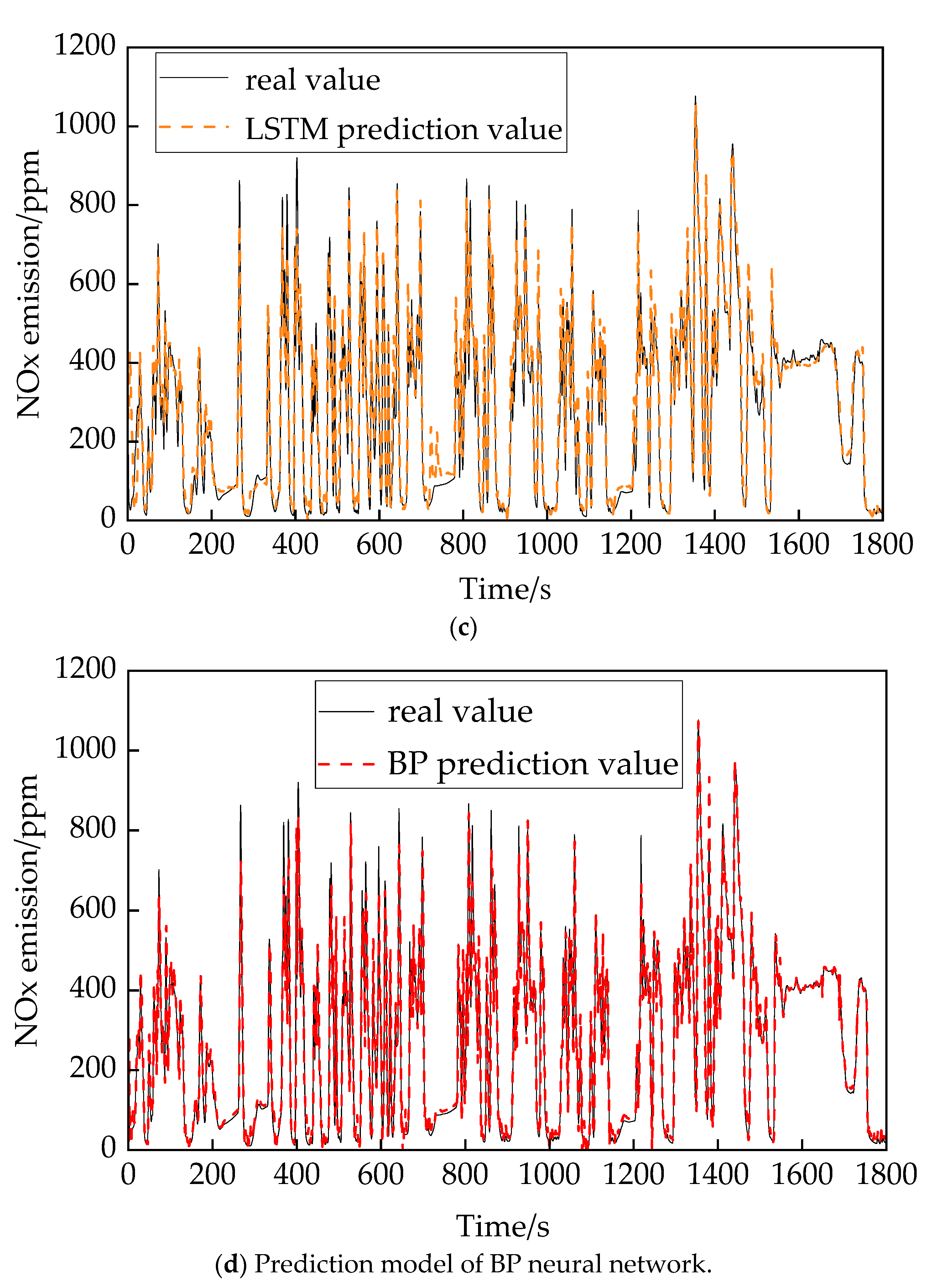
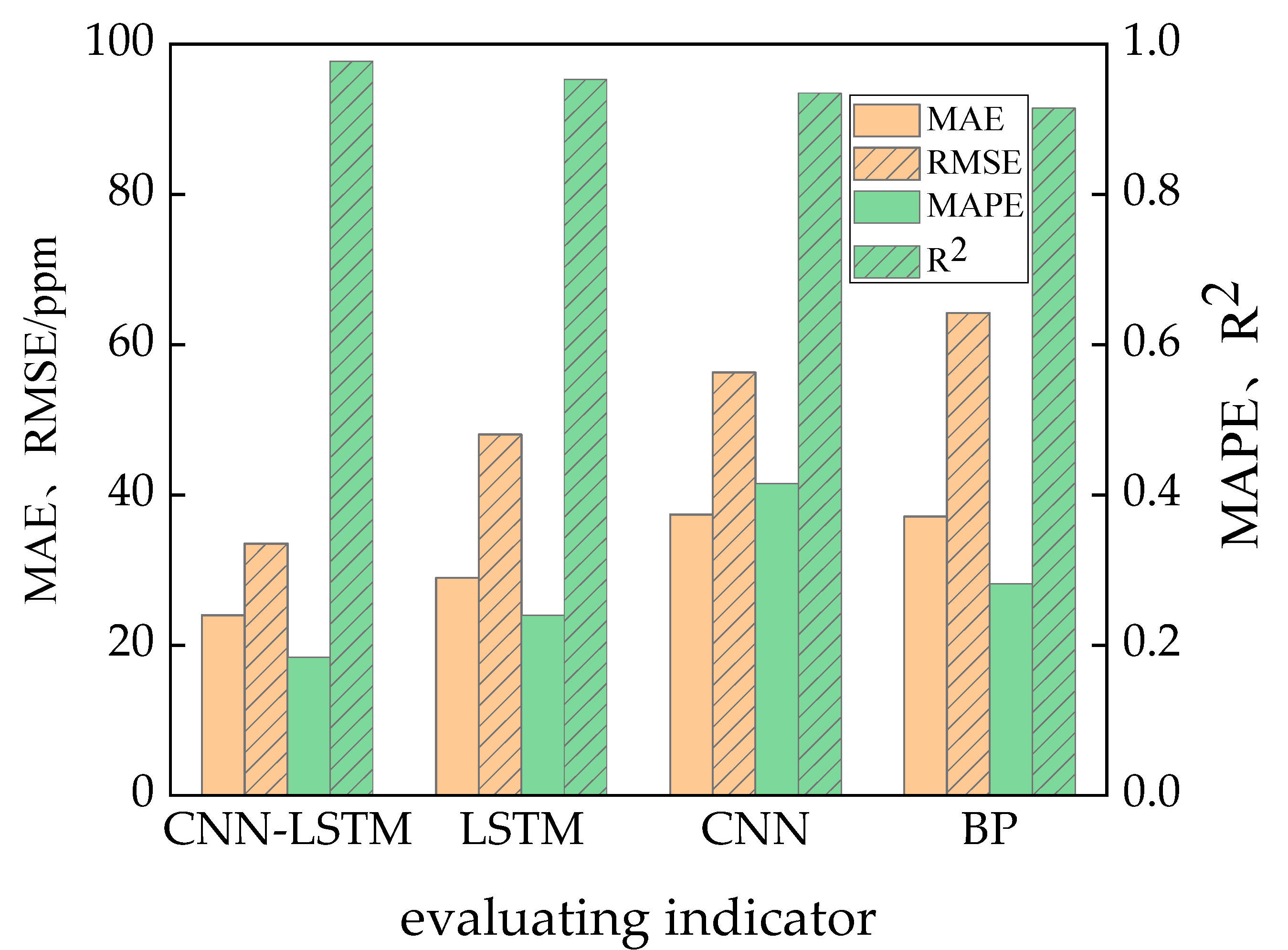

| Parameter Description | Details |
|---|---|
| Model | D25TCIF |
| Engine type | Electronically controlled high-voltage common rail and In-line four |
| Bore × stroke | 92 mm × 94 mm |
| Displacement | 2.499 L |
| Rated speed | 3000 rpm |
| Maximum torque | 450 N·m |
| Maximum power | 120 kw |
| Maximum injection pressure | 1,600,000 hpa |
| Fuel injector flow rate | 478 (cm3/30 s) |
| Nozzle diameter | 0.135 mm |
| K coefficient | 1.3 |
| Parameter Description | Title 2 | |||||||||
|---|---|---|---|---|---|---|---|---|---|---|
| Sampling time/s | 1 | 2 | 3 | 4 | 5 | …… | 1797 | 1798 | 1799 | 1800 |
| Rotation speed/(r·min−1) | 804.6 | 801.3 | 800.6 | 800.6 | 800.0 | …… | 789.9 | 802.5 | 791.9 | 797.5 |
| Torque/(N·m) | 4.690 | 2.360 | 1.830 | 0.080 | 0.400 | …… | 9.050 | 1.820 | 1.730 | 1.990 |
| Intake air flow/(kg·h−1) | 50.060 | 49.250 | 48.580 | 48.640 | 48.760 | …… | 51.870 | 53.180 | 53.020 | 55.010 |
| Pre-injection timing/°CA | 4.329 | 4.153 | 3.582 | 3.647 | 3.538 | …… | 7.712 | 7.075 | 7.163 | 7.8 |
| Pre-injection quantity/(kg·h−1) | 1.600 | 1.580 | 1.540 | 1.540 | 1.520 | …… | 1.540 | 1.500 | 1.500 | 1.560 |
| Total fuel injection quantity/(kg·h−1) | 7.520 | 7.320 | 6.300 | 6.580 | 6.300 | …… | 5.680 | 3.040 | 3.040 | 5.980 |
| Fuel pressure/bar | 0.509 | 0.509 | 0.504 | 0.502 | 0.504 | …… | 0.451 | 0.450 | 0.448 | 0.448 |
| Atmospheric temperature/°C | 24.630 | 24.600 | 24.620 | 24.640 | 24.640 | …… | 22.010 | 22.010 | 22.020 | 21.980 |
| Atmospheric humidity/% | 51.582 | 51.527 | 51.531 | 51.549 | 51.531 | …… | 52.470 | 52.470 | 52.470 | 52.440 |
| Fuel temperature/°C | 29.300 | 28.900 | 28.700 | 28.500 | 28.300 | …… | 30.500 | 30.500 | 30.500 | 30.500 |
| NOx value/ppm | 45.7 | 34.8 | 50.1 | 80.1 | 85.6 | …… | 20.1 | 18.8 | 17.8 | 17.1 |
| Parameter Description | Spearman | Pearson |
|---|---|---|
| Rotation time/s | 0.4 | 0.42 |
| Torque/(N·m) | 0.42 | 0.48 |
| Intake air flow/(kg·h−1) | 0.53 | 0.48 |
| Pre-injection timing/°CA | 0.43 | 0.45 |
| Pre-injection quantity/(kg·h−1) | 0.35 | 0.14 |
| Total fuel injection quantity/(kg·h−1) | 0.44 | 0.49 |
| Fuel pressure/bar | −0.41 | −0.42 |
| Atmospheric temperature/°C | −0.22 | −0.22 |
| Atmospheric humidity/% | 0.15 | 0.14 |
| Fuel temperature/°C | −0.12 | −0.15 |
| Neural Network Model | MAE | RMSE | MAPE | R2 |
|---|---|---|---|---|
| CNN-LSTM | 23.981 | 33.495 | 18.4 | 0.977 |
| LSTM | 28.982 | 48.023 | 24.0 | 0.953 |
| CNN | 37.380 | 56.287 | 41.5 | 0.935 |
| BP | 37.156 | 64.208 | 28.2 | 0.915 |
Disclaimer/Publisher’s Note: The statements, opinions and data contained in all publications are solely those of the individual author(s) and contributor(s) and not of MDPI and/or the editor(s). MDPI and/or the editor(s) disclaim responsibility for any injury to people or property resulting from any ideas, methods, instructions or products referred to in the content. |
© 2023 by the authors. Licensee MDPI, Basel, Switzerland. This article is an open access article distributed under the terms and conditions of the Creative Commons Attribution (CC BY) license (https://creativecommons.org/licenses/by/4.0/).
Share and Cite
Shen, Q.; Wang, G.; Wang, Y.; Zeng, B.; Yu, X.; He, S. Prediction Model for Transient NOx Emission of Diesel Engine Based on CNN-LSTM Network. Energies 2023, 16, 5347. https://doi.org/10.3390/en16145347
Shen Q, Wang G, Wang Y, Zeng B, Yu X, He S. Prediction Model for Transient NOx Emission of Diesel Engine Based on CNN-LSTM Network. Energies. 2023; 16(14):5347. https://doi.org/10.3390/en16145347
Chicago/Turabian StyleShen, Qianqiao, Guiyong Wang, Yuhua Wang, Boshun Zeng, Xuan Yu, and Shuchao He. 2023. "Prediction Model for Transient NOx Emission of Diesel Engine Based on CNN-LSTM Network" Energies 16, no. 14: 5347. https://doi.org/10.3390/en16145347
APA StyleShen, Q., Wang, G., Wang, Y., Zeng, B., Yu, X., & He, S. (2023). Prediction Model for Transient NOx Emission of Diesel Engine Based on CNN-LSTM Network. Energies, 16(14), 5347. https://doi.org/10.3390/en16145347





